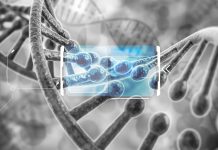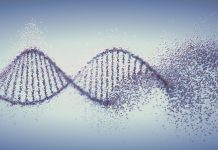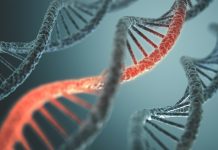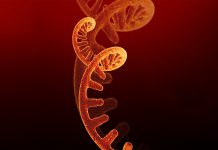Genetic testing is a new frontier in preventive medicine. But beyond this border, there lies a minefield of trial and error.
DNA is the instruction manual for building and operating the body. It’s in almost every single cell we have. The first to identify its existence was an Augustinian monk named Gregor Mendel. In 1866, Mendel published an article in which, based on his research on about 30,000 plants, he argued that the transmission of traits from one generation to another follows some laws governing this heritage. His demonstration failed to convince others and was ignored for several decades until an American biologist, Thomas Hunt Morgan, determined to prove Mendel’s conclusions wrong, eventually came to agree with him. In 1933, Morgan received a Nobel Prize for “his” discoveries on the role of chromosomes in heredity.
Morgan only gave an outline of the study in the field, but after him, researchers like James Watson and Francis Crick, who deciphered the structure of DNA in 1953, and Marshall Nierenberg, who deciphered the genetic code in 1961, overcame barriers to deeper knowledge of the field. The new discoveries culminated in 2003, when the Human Genome Project managed to map 99% of human DNA, right before the deadline that was set by the international consortium working in this field.
Nowadays, the Human Genome Project has been repeated in very specific branches of genetics. According to some estimates, the Cancer Genome Atlas would be the equivalent of 20 Human Genome Projects. But subsequent discoveries have only managed to broaden the horizon within the same paradigm, without going beyond its limits.
“Those who have expected dramatic results overnight may be disappointed, but we should remember that genomics is subject to the First Law of Technology: we invariably overestimate the short-term impact of new technologies and underestimate their effects in the long run,” said Francis Collins, who led the National Institute for Human Genome Research (USA) from 1993-2008.
Between the short-term impact and the long-term effects of genetic testing, there are many challenges and dilemmas that, in their spiral dance towards knowledge of DNA, involve not only researchers, but also ordinary people. A few real cases, differing widely from one another, show us why.
Innocence by DNA
When he was 16, Josiah Sutton was unjustly imprisoned for allegedly raping a 41-year-old woman in Houston. The woman had been kidnapped with her own car, from the parking lot in front of her house, and raped by two individuals. A few days after the attack, the woman saw Josiah walking down the street with a 19-year-old neighbour. She alerted a police patrol passing by, and officers arrested the young men. From the beginning, the two denied the accusations, and both had alibis for the night of the attack. Moreover, none of them matched the description of the attackers the woman had made in the first statement she gave the police. Josiah and his friend were much taller and stronger than the attackers.
Frightened by the unjust accusation, but also confident that science would be on the side of the truth, the two young men agreed to have their blood taken to be tested and their innocence established. While they were still under arrest, blood samples were analysed by the Houston Forensic Laboratory, which had to extract and amplify fragments of both young men’s DNA until the distinct genetic markers became visible. The laboratory had to compare the results with the DNA obtained from the victim’s clothes, from a semen stain on the seat of the car, and from the vaginal secretion of the abused woman (who presented triple evidence: the victim’s DNA and DNA from the two attackers). Following the tests, the laboratory did not directly incriminate Josiah, but reported that one of the tests tested positive: Josiah’s sample was congruent with the mixture in the vaginal secretion. A jury sentenced the teenager to 25 years in prison.
Four years later, a journalistic investigation unequivocally proved that the Houston lab had made some serious mistakes, and had failed to report significant inconsistencies to the jury. As a result, Sutton was released. Two years later, a repeat offender pleaded guilty to the rape.
The possibility of making errors in a DNA analysis has unfortunately increased parallel to the refinement of testing techniques and parallel to the increase in public confidence in this form of “fingerprinting”.
Until 2014, when A. Kloosterman and colleagues published a comprehensive study of error rates in forensic DNA analysis, there were few studies in the medical literature that made these errors public. In all scientific fields, it is good practice to define and make public the error rate. According to Kloosterman, between 1997 and 2007, the error rate of four investigated laboratories in different countries ranged from 0.31% to 0.61%. But this translated into a few dozen to a few hundred errors per quarter year.
In 2018, the largest study on the effectiveness of forensic DNA testing found that 74 of the 108 forensic laboratories in the US and Canada that were evaluated comparatively, based on the analysis of the same data set, would have unjustly convicted a suspect.
The popularisation of DNA fingerprinting in films is partly responsible for cultivating public confidence in DNA profiling, and this is a problem because, as Erin Murphy, a law professor at New York University, puts it, “Just because science is advancing doesn’t mean that there are no more mistakes along the way”.
A mutilated destiny
A terrible mistake dramatically changed the trajectory of a young teacher and her family. Katy Mathes had recently turned 30, was married, and had a son when she decided to assess her cancer risk with a genetic test. The results brought her the news that she had a mutation in the BRCA gene, which significantly increases the risk of developing ovarian or breast cancer. She decided to have preventive surgery. Doctors removed her ovaries, fallopian tubes and breast tissue on both breasts. A long and difficult period of recovery followed.
For nine months, Katy could not lift her baby in her arms, could not bathe him, or even hug him. Her mother, sister, cousins and aunts also took the test, which showed that eleven of them had a risky mutation. Seven decided, like Katy, to have preventive surgery.
But four years later, the lab that had performed the tests returned to the results, telling them that there had been a change in their cancer risk assessment. “From ‘a very high risk’ of 84%, I had dropped to zero,” Katy said in an interview. “I had felt I had done something for my family. That I needed those operations to save them. And then the realisation that I didn’t really need to do any of this hit me hard.”
Myriad Genetics, the company that tested the women, later said that the reclassification of risk occurs “extremely rarely” and that “as science evolves, we analyse any new information and reclassify only after very careful checks.”
Unfortunately for Katy, the “careful” check at the time of the first test meant an immense but ultimately unnecessary pressure on her health, and the health of her marriage. Removal of the ovaries and fallopian tubes, and therefore of reproductive hormones, triggered premature menopause. But the lack of reproductive hormones also decreased her libido and skin health, and may also have affected her cognition and memory.
Maureen Boesen, whose family history of BRCA1 carriers spanned countless generations, had also prepared for the same experience. In fact, Maureen’s family was even part of the pilot study that first detected the BRCA1 gene mutation. As with Katy, Maureen received a positive first test for the gene in question. After a double mastectomy, she skeptically repeated the test before the operation on her reproductive system. The result threw her into great emotional turmoil. She had no threatening genetic mutation.
American oncologist, Pamela Munster, also received a negative result, after taking a 23andMe test, by mail, in 2010. At the time, 23andMe was a new company. Meanwhile, many have learned how easy it is to get a genetic test through this company: order a kit, which arrives at home by mail. You collect saliva in the container they send you, send it back, and then you receive the results. Two years later, Pamela was diagnosed with breast cancer and repeated her test with another company. This time, her result was positive.

Pressure on the psyche
Last year, a study of 100,000 people showed that Pamela’s experience was far from unique. About 90% of 23andMe test participants received false-negative results for the BRCA gene because the 23andMe laboratory’s risky testing formula was built on only three genetic variants, which were most often prevalent among Ashkenazi Jews. But the study showed that most people who have this gene carry a variant other than the three the formula was built on.
Another study, which looked at the accuracy of a commercial DNA test, found that it was only 17% accurate when it identified a mutation in the BRCA gene. It failed to detect more than half of the people who actually had this mutation. The sample size used to obtain this result was 50,000 people. In an interview with The Guardian, geneticist Caroline Wright described the results as “shockingly stupid. So much so that it makes you wonder if it’s better not to transmit this data. It can be terribly harmful for a person to find out that such information is completely wrong.”
A study published by Market Research Future estimated, based on current sales of genetic testing in Europe and in several countries outside the continent, that the global genetic testing market will grow by 12.94% by 2023. But the level of psychological counseling needed to accompany this testing does not keep pace with sales. In Italy, for example, only 12% of those who request genetic testing also receive pre/post-test psychological counseling.
How to regain control
Research published by Nature showed that no less than 40% of tests ordered online and mailed to the testee produce false results. Medical genetic testing performed in medical institutions is more detailed and expensive, but far more viable, because these institutions go through various external controls to assess the quality of the services they provide.
In the case of genetic testing for medical purposes, the errors that occur are systemic in nature, and can affect different stages of analysis. Some of these problems include doctors being insufficiently trained in the use of genetic testing in treatment, samples sometimes being inadequate or contaminated, or the interpretation of results simply being incorrect. But none of the above cases can be used as an argument against the use of genetic testing, because, in each of the situations described, what provided clarity was also a genetic analysis.
However, one practical conclusion does emerge from all these life stories: it is expected that, in a field as young as genetic testing, mistakes will abound. And because the implications of these mistakes can sometimes be tragic, very thorough research is vital before choosing a genetic testing provider.
The Internet is a reliable source, if we use it wisely. We should look for places where the name of the company we want to use appears, check that the company has been audited by authorised quality assessment networks, and look for customer experiences of that company. We ought to be careful that these are published not as an advertisement on the company’s website, but from an impartial source. We should also look for the company in research in English, on sites dedicated to the publication of medical studies (e.g. PubMed), because sometimes we can be unpleasantly surprised.
As we have already shown, the news of a genetic risk can profoundly affect a person’s life. Because of this, it is desirable that, before and after the genetic testing, the person being tested should benefit from counseling. Finding out about an increased risk of cancer does not automatically cause anxiety or depression, but the testee should have recourse to psychological and emotional support.
Psychologists generally say that the factors influencing the perception of risk of illness are those that predispose one to the development of mental disorders. On the one hand, if the person perceives the disease as serious, uncontrollable and untreatable, this can generate a negative psychological response. On the other hand, greater clarity on one’s genetic profile can translate into medical benefits for the person being tested. A positive genetic test can eliminate the doubts or relieve the fears of a person living in uncertainty. This can cause the tested person to adopt healthy behaviours that can help delay or even prevent the activation of the threatening gene. Emotions can be a very strong motivator in the decision to change health behaviours.
The decision of whether or not to be genetically tested for hereditary diseases, therefore, has very complex implications. But the mere fact that the scientific community is talking today about “preventive medicine” and “epigenetics” (the process by which various genetic mutations can be silenced by adopting a lifestyle that promotes health), is in itself good news. Even if we want to find out our potential for genetic risk, the best decision we can make now for our health is to cultivate healthy habits. Such a decision will never be regretted.
Alina Kartman is a senior editor at ST Network and Semnele timpului.


















